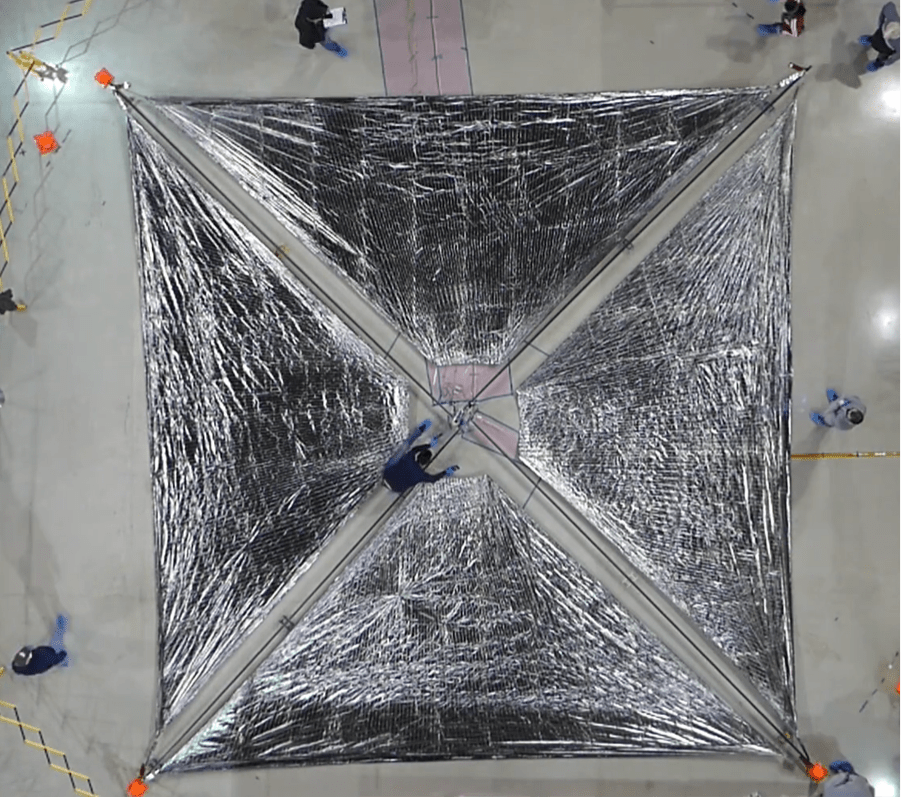

What is Solar Sail?

A solar sail is akin to the sails that adorned medieval ships; albeit with a cosmic twist. Picture a spacecraft equipped with an expansive; thin sail made of reflective material. Instead of relying on the wind; this sail harnesses the pressure of sunlight to propel the spacecraft forward through the cosmic expanse.
How does Solar Sailing work?
Light is made up of particles called photons. Photons don’t have any mass; but as they travel through space they do have momentum. When light hits a solar sail — which has a bright; mirror-like surface — the photons in that light bounce off the sail (i.e. they reflect off it; just like a mirror). As the photons hit the sail their momentum is transferred to it; giving it a small push. As they bounce off the sail; the photons give it another small push. Both pushes are very slight; but in the vacuum of space where there is nothing to slow down the sail; each push changes the sail’s speed.
How does a solar sail control its direction?
When a solar sail faces the Sun directly; photons push the spacecraft forward; away from the Sun. But a solar sail can move in other directions by tacking like a sailboat; changing the angle of the sail relative the Sun. It’s even possible to shift the spacecraft's orbit around the Sun; by angling the sail so that solar photons push against the direction it is traveling. Solar sails can also control their direction in other ways; such as changing their center of mass or using tip vanes.
What is the advantage of solar sailing?
Spacecraft gain most of their momentum when they are launched from Earth; and then most increase their speed or change course using chemical rockets that burn fuel that the spacecraft carries on board. But more rocket fuel means more weight; which limits how much can be carried. Most spacecraft reach their maximum speed and then coast through space or rely on gravity assists from other planets to reach their destinations.
With solar sails; a spacecraft can continue accelerating as long as there is light pushing on it. Within a solar system; sunlight can continuously push on the sail; accelerating the spacecraft throughout its entire voyage. This means that solar sail-propelled spacecraft can reach speeds that would be practically impossible for chemical rockets to achieve.
Solar sailing spacecraft are also advantageous because they can be placed in orbits that would otherwise be unstable by using the sail acceleration as a balancing force. As an example; this could enable solar monitoring missions to sit between the Earth and Sun at a closer distance than otherwise possible to provide more warning of solar storms.
How fast can a solar sail go?
A solar sail’s speed depends on its size and its mass. A bigger sail captures more sunlight; gaining more momentum and accelerating more quickly for the same mass. For a given sail size; a lower mass spacecraft will have a higher acceleration. The acceleration also depends on its distance from a light source and strength of the light source. As a solar sail spacecraft gets farther away from the Sun; the amount of sunlight available to it decreases; meaning that it accelerates less quickly. Theoretically; powerful lasers could be aimed at a distant solar sail; providing some extra acceleration as the spacecraft gets further from the Sun.
How expensive is solar sailing?
Building a solar sail; especially a very large one; is a feat that still needs development. And that research and development can be expensive. But once solar sails are better tested and understood; they could be a relatively inexpensive means of propulsion. Sunlight is free and unlimited; meaning that a solar sail-propelled spacecraft could travel greater distances without having to increase the amount of fuel it carries on board; and could potentially use smaller; cheaper launch rockets for the same trip. So to travel at great speeds to distant destinations; or to provide long term stability in an otherwise unstable orbit; solar sailing could be an affordable option.
Who has built solar sails? What solar sailing missions exist?

Since the failed Cosmos 1 mission; solar sails have been successfully built and launched by the Japanese Aerospace Exploration Agency (JAXA) with their IKAROS spacecraft that first demonstrated controlled solar sailing; by NASA with their NanoSail-D spacecraft; and by The Planetary Society with our LightSail 1 spacecraft.
Many more solar sailing missions are in development; including The Planetary Society’s LightSail 2 mission and NASA’s NEA Scout mission to a near-Earth asteroid. NASA’s Advanced Composite Solar Sail System; or ACS3; launching in 2022 will test out a larger sail in Earth orbit than previous missions. NASA’s Solar Cruiser mission launching in 2025 will test an even larger solar sail the size of over six tennis courts.